
In May 2015, we were staying in a machiya in the East of Kyoto and were thinking of things we hadn’t done in Kyoto before. My husband has long wanted to visit a flea market at a temple. The only time we’ve sort of done this before is when we went to Kitano Tenmangu, where a very small flea market was being held among the food stalls and plastic tat aimed at children.
I read up on shrines in Kyoto that hold regular markets, and discovered that Kami Goryo Jinja in the north of the city had a monthly market that fell while we were in Kyoto. I wish that the information I’d found had included this site, because then I would have known that the flea market isn’t held in May!
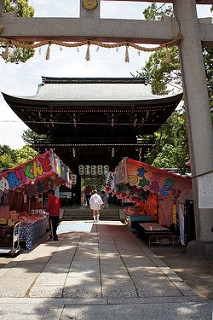
Instead, the 18th May is the date of the shrine matsuri, which is one of the oldest continuously held matsuri in Japan. The shrine has a long history, dating back to 794. It was built on the site of a former Buddhist temple which had served the local population as a family temple until the imperial court moved from Nara to Kyoto and Emperor Kammu ordered that a Shinto shrine be established on the site. Kammu dedicated the shrine to eight spirits of people who had died violently, and Kami Goryo Jinja became the guardian shrine of the Imperial Palace. The role of the shrine became one of protection, with the kami driving away vengeful spirits which threatened the safety of the capital.


Things didn’t work out so well with the kami, as the 15th century Onin war started in the forest around the shrine, and the shrine itself was burned to the ground during the decade long battle. (We’d learnt a little about the Onin war as a result of our visit to Ginkakuji.)
A century later, the Shogun Toyotomi Hideyoshi rebuilt the shrine. Under the Shogunate, Kami Goryo Jinja ceased to be the guardian shrine of the Imperial Palace and reverted to being a family shrine, protecting the local population.
The matsuri has been held at the shrine since 863, and features three mikoshi, a variety of ox carts, taiko drummers, dragon dancers and local children dressed in Heian era costume. The spectacle more than made up for the lack of a flea market!
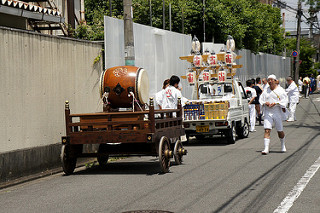
We arrived just as things were getting started. Small trucks and wagons were parked up in the street in front of the shrine entrance. Among the wagons was a beautiful ox cart. A couple of men were inspecting the cart to make sure it was ready for the procession.

The man on the right noticed us taking photographs and walked over to chat. One thing we learned about the Kami Goryo Jinja matsuri is that the local people are incredibly proud of the festival, and were pleased to see tourists visiting. We had a short conversation in Japanese about what was going on, and he gave us some advice on where to stand to see the mikoshi pass by once they left the shrine precincts. We thanked him and then made our way into the shrine, because we could hear flutes and bells, so thought something must be happening.
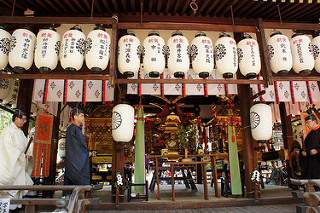

How right we were! The purification ceremony was just beginning, and we joined the local people in watching as the shrine priests waved a willow wand over the mikoshi and then offered sake, mochi, fish, vegetables and fruit to the kami in their temporary homes.
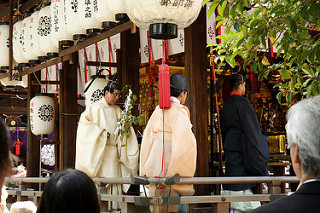





The ceremony was beautiful to watch, executed with solemnity and grace. It felt like a privilege to be there, witnessing it. We only saw three other Western visitors, which interested me because the shrine is located not far from Kyoto University. When we’ve wandered briefly around the Demachiyanaga area, we’ve noticed a reasonable number of Western students, but perhaps they don’t live in the area near the shrine.
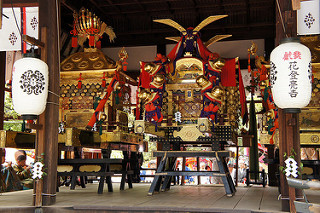
After the blessings and offerings, the shrine carriers started to prepare. They were dressed in dazzling white happi coats. Among the crew for one of the mikoshi was a Western man. What an honour to have become such a part of the community around the shrine that he was part of a mikoshi crew! I think he’s on one of the videos I recorded, but I didn’t get a photograph of him, unfortunately.

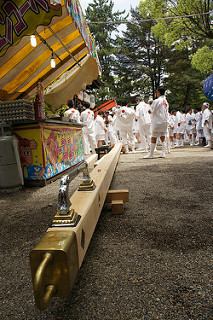
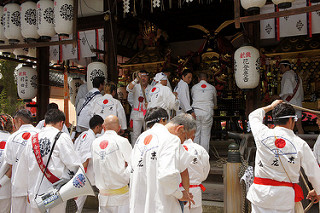
Around the other side of the shrine to where we were standing, musicians sat and accompanied the ceremony.
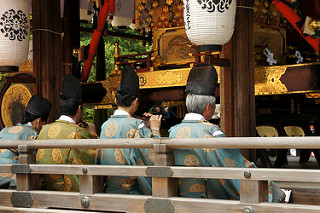
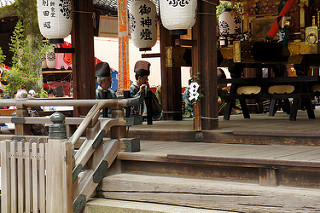
I always think that traditional Japanese music has an eerie melancholy about it. It fitted well with the ceremony, somehow.
Also standing around the shrine, watching the mikoshi crews get ready, were children dressed in Heian era costumes. The head priest passed through the crowd with his willow wand and blessed the children.


Less benign were the dragon dancers who snapped their mouths and threatened to bit the heads off the children. One small boy burst into tears at their antics, but the two young ladies dressed in red took the abuse stoically!


At one point, while I was wandering around, I got a little too close to the ropes that would be used to tie the mikoshi to their carrying poles. One of the mikoshi crew warned me not to step too close. When I stepped back and said, “はい、わかりました,” (yes, I’ve understood what you’ve told me) he nodded back to me and gruffly said, “ごめん”. Judging by the expression on his face, I think he meant that he was sorry that he had scolded me!
Suddenly the mikoshi were ready, and with a lot of call and response, the mikoshi crews put on a great performance of bouncing the portable shrines off the main shrine platform and out into the street. The mikoshi are decorated with bells, so there was a lovely jingling to the movement, and this mixed with the shouts of the men as they bounced the shrines on their poles. It was amazing to see.
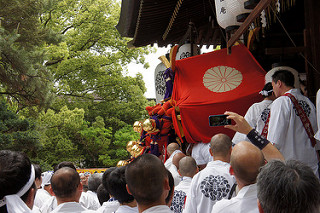
The mikoshi were carried out through the East gate, so we headed back through the South gate to the spot pointed out to us by the ox cart checker earlier that morning. He was right about it being a good place. We saw the ox arrive and be harnessed to the cart, then a parade of costumed people, followed by the first mikoshi, which was put onto its wagon right in front of us. That was a precision operation, getting it to sit right.
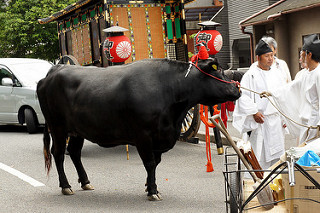
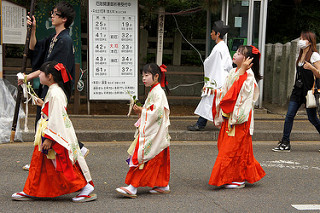

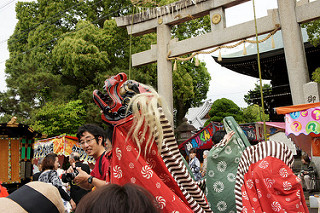



I really loved this matsuri. It felt cosier than the Sanja Matsuri in Asakusa that we stumbled upon during our honeymoon. As we left the streets around the shrine and started to walk towards the river, looking for the vegan restaurant Mamezen, we could hear the procession making its way along the streets that encircle the shrine. As we crossed a bridge over the river, a man cycling the opposite way shouted over his shoulder to us, “祭り、祭り!” (matsuri, matsuri!) and gestured at the parade behind us. “はい、見ました、凄いです!” I replied. (Yes, we saw it, it’s amazing!) He seemed to be satisfied with that response, and cycled on his way. How lovely, though, that he was so proud of his local festival that he stopped some random strangers he thought might be missing out and urged them to turn back.
If you’re in Kyoto on the 18th of May, any year, then this matsuri is definitely worth a look. We took the Karasuma line on the Kyoto subway to Kuramaguchi station, then walked through back streets to reach the shrine. The circular flat fare 201 bus will drop you off at the Karasuma Imadegawa subway station as well, and you walk north from there. 楽しんで下さいね! (Enjoy!)
Posted by Along the Kamogawa (鴨川) | Japanophile on 20/09/2016 at 12:20 pm
[…] we spent more time walking along a stretch of the river to the north of the city. We had been to a festival at Kami Goryo-jinja and walked north to find somewhere to eat. Kami Goryo-jinja is west of the Takano river, which we […]